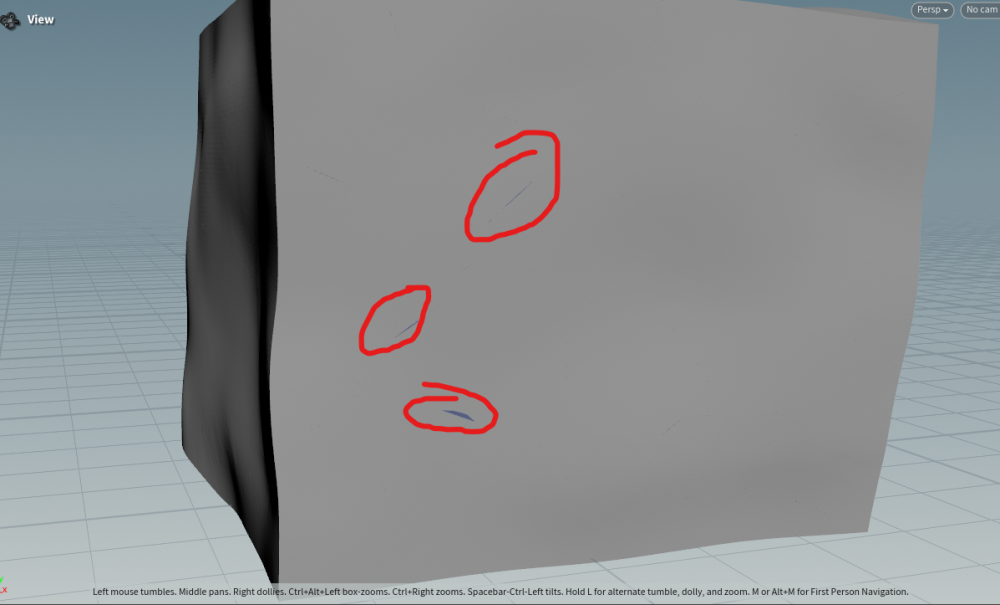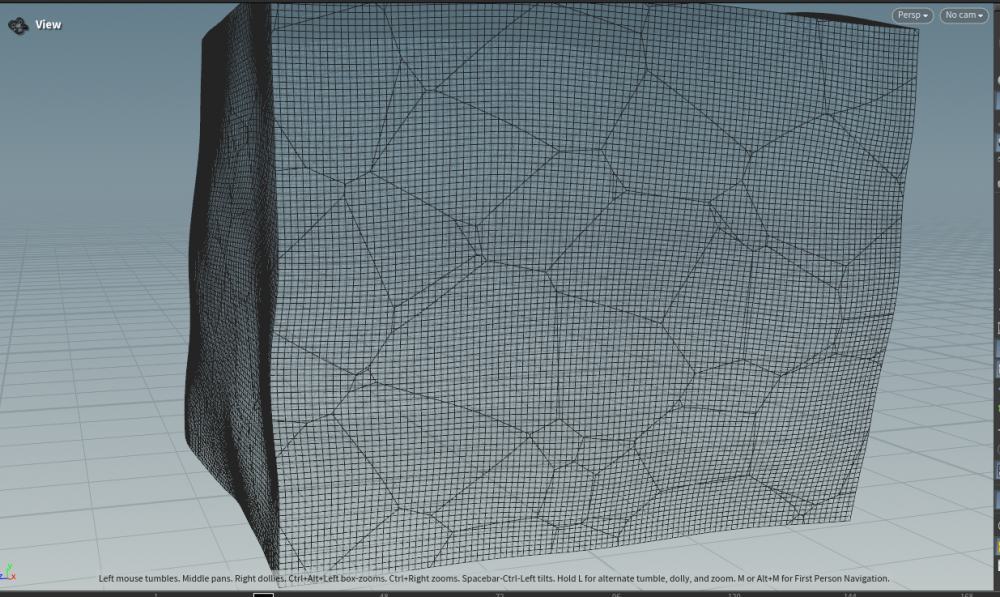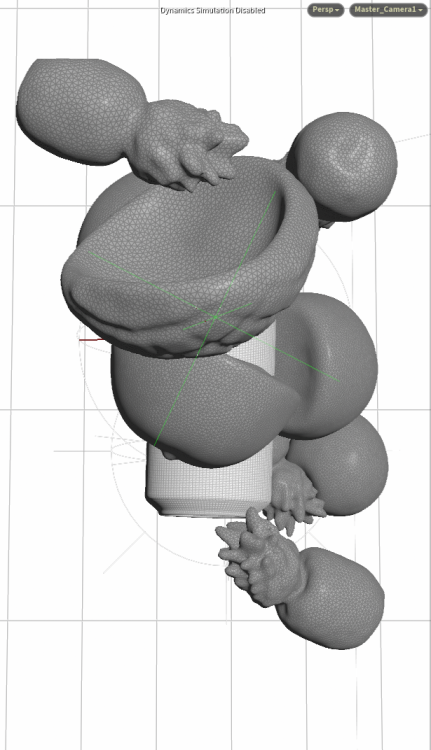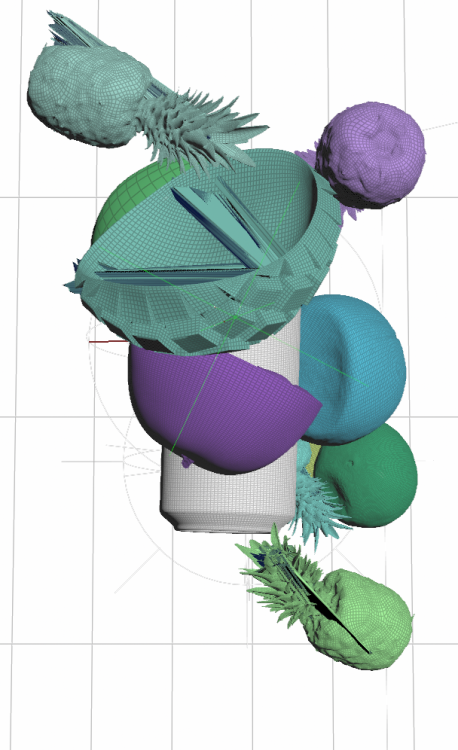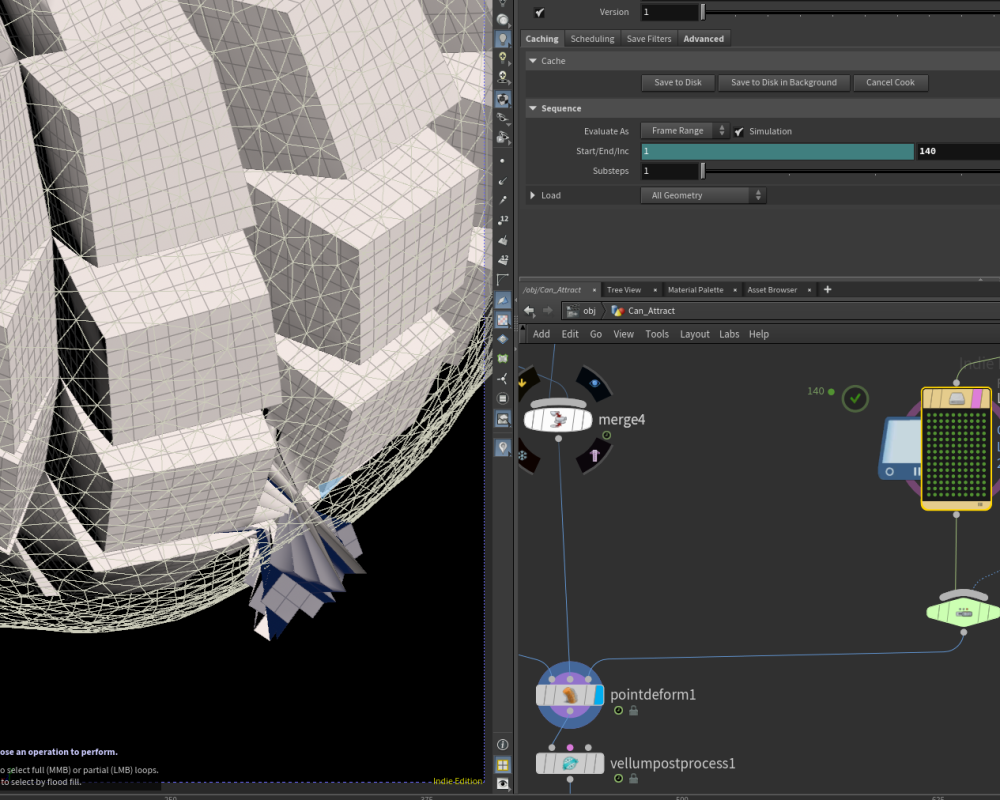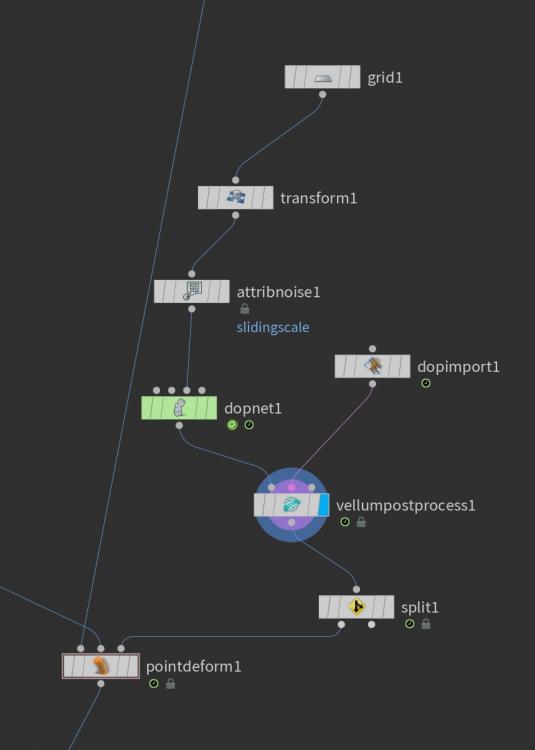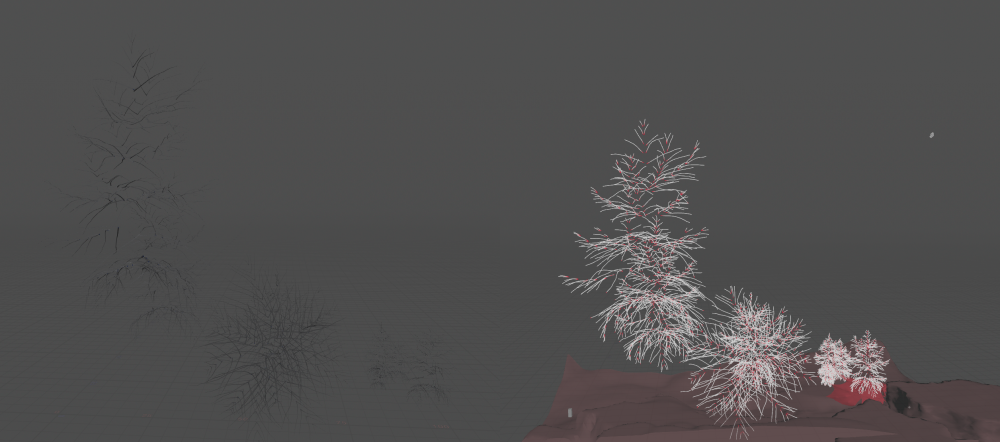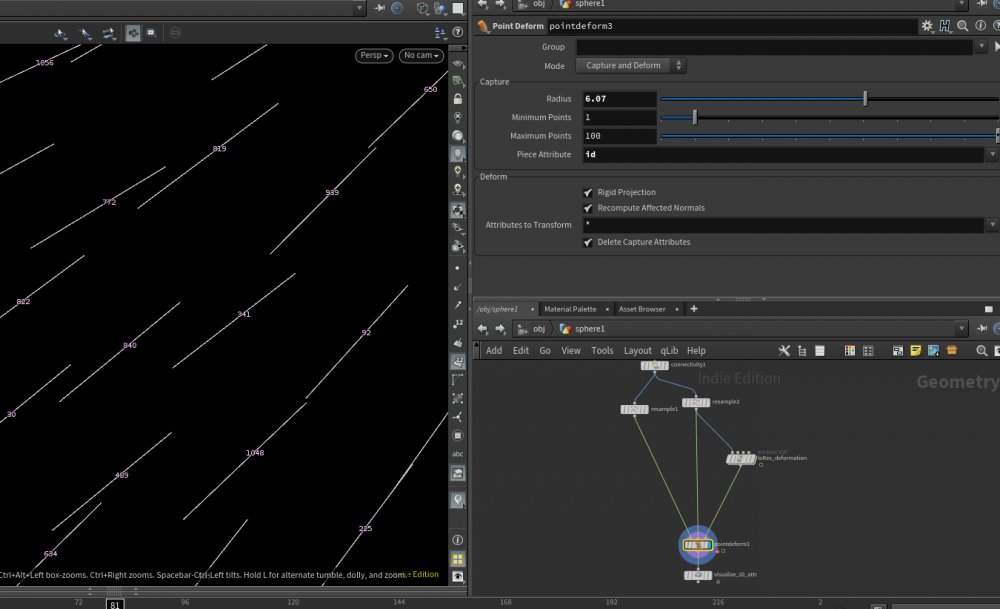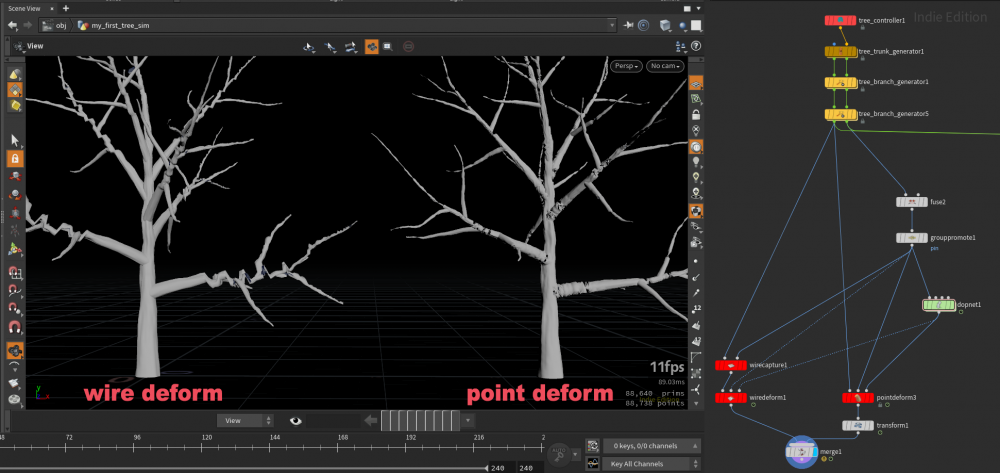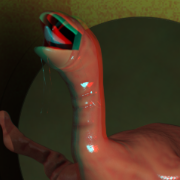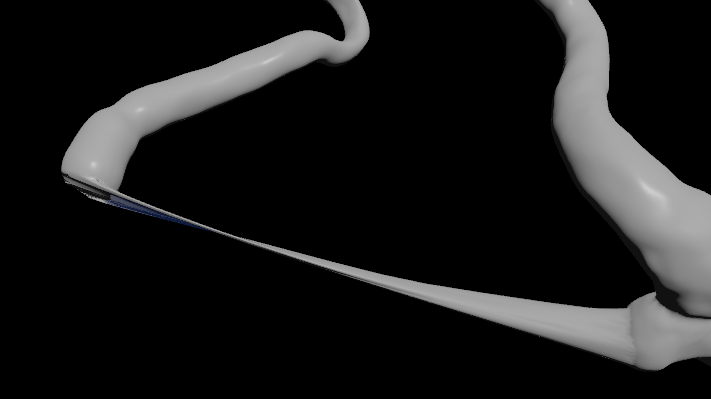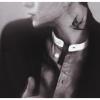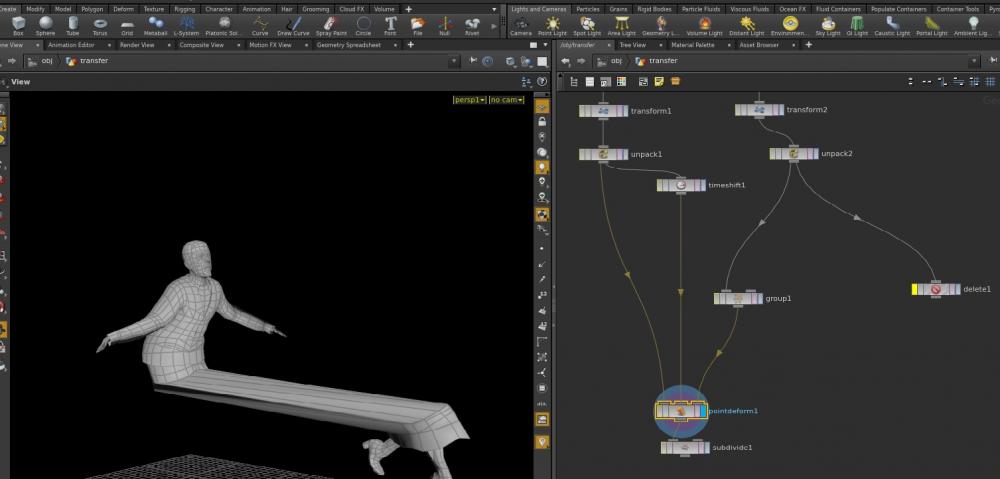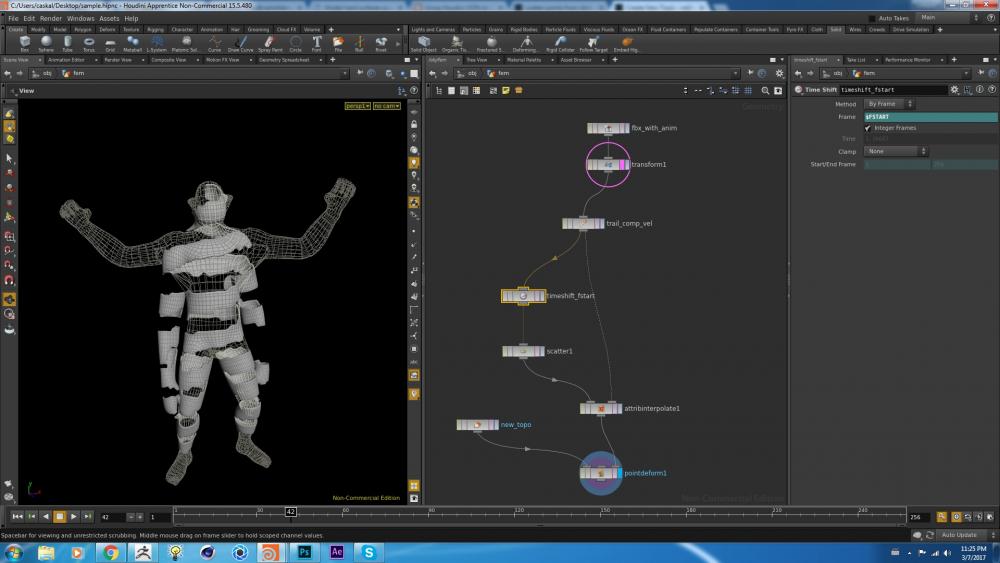Search the Community
Showing results for tags 'point deform'.
-
im trying to point deform RBD fractured object , but it seems im getting normals issue or maybe overlaping faces ,i have tried to increase the max points on point deform but still appear on some spots, is it because of bad topology ? or am i missing something ? Note: im deforming the fractured object because later on i want to dynamically remove constraints . point deform issue.hip
-
Hi, can I please get some pointer here. I am working on a vellume sim using POP attract node. Then replacing low res after simulation with High Res using Point deform. My problem was after replacing the Low Res, the high poly model ran into some geometry problem after it collide with high speed moving object ( in this case, it hit the can and wall). I have looked into the Capture Radius, Minimum points and Maximum points. But I find it hard to understand what it meant to do. Tri is the low res sim, and the quads is high res ( error appear from the very first frame, hence I suspect it is from my lack of understanding Point Deform node ) Below is the simulation using the Low res ( no error) Below is replaced by the Hi res model, as we can see the stretched poly after collision. the end of the stretch is fixed to a spot in the air. And here is the Point Deform screen Grab.
- 2 replies
-
- houdini
- point deform
-
(and 2 more)
Tagged with:
-
hello. i am emitting a couple of objects in a vellum sim and want to point deform them at the end. everything works fine except only the first object gets point deformed and you can only see the collisions of the other point deformed objects. they seem to get emitted but don´t show up in the viewport. the constrains are there but the geo keeps missing. tried different inputs for the point deform but can´t get it to work.... WindowMan.hiplc
-
Hello, I'm breaking a tree with bunch of branches. So everything work fine with RBD and I manage to create bone for each branch then stick them to the animated rigid mesh. But when I use point deform to deform the original mesh with the bones then I get a heavily distorted result I checked multiple times with attributes and I'm pretty sure the values are matched. I google for weeks and can't get around it. This is the file. I think this amount is enough but if not I can update it right away. I hope someone can point out where did you do wrong. Thank you for reading this. ASk_PointDeform_v2.hipnc
-
Hello, I'm trying to get a point deform sop to deform hi-res hairs by simulating lo-res hairs and using the point deform sop however the piece attribute is not working as expected. If I have a point id attribute on the curves, the deformation doesn't work at all. In the first image, I am deforming only 1 lo-res curve by using the id attribute as a mask. The second image is the resulting hi-res curves supposedly deformed by the point vop. I've noticed if I don't use the id attribute, the curves will deform properly however I need the piece attribute functionality since the hairs will be overlapping one another. Any ideas? pointDeformPieceNotWorking.hiplc
- 3 replies
-
- point deform
- id
- (and 5 more)
-
Hey everyone, I'm trying to make a tree simulation. I'm using wire solver, but I can't figure out how to deform the tree geo with the simulated curves. I tried wire deform and point deform, but the result is strange. Do you have any idea? tree_deform.hiplc
- 17 replies
-
- tree
- point deform
-
(and 1 more)
Tagged with:
-
I have a Vellum setup that is working great, until I change one small parameter... I'm using an initial RBD sim to hover 4 low res objects in a big group in the air. I then turn those objects into Vellum cloth, so I can drop them in a big bouncy pile on the ground. Lastly I deform the 4 low res objects with a Point Deform SOP onto the high res geometry. This works totally fine when I only scatter one of each object. The problem quickly appears when I scatter more than one of each object in the initial floating RBD pile. I sort of understand why this is happening, but I can't get my head around fixing this procedurally. I think the high res objects can't be moved into the position of the low res geo because (once scattering more than one of each object) there is no longer a name (or class?) to define each and every object independently. I am stumped in finding a way to fix this sensibly without me having to manually make multiple copies of each object with independent naming. Any ideas would be greatly appreciated! Scene file attached. Vellum_Low_To_High_Res_Deform.hip
-
Hello, I'm new to Houdini and this is probably very simple. I have a simple scene file that was made with the Entagma vellum tutorial https://vimeo.com/294374382 How would I use point deform to apply the high-res pig head on to the low-res pig heads with the dopnet continuously emitting the pig heads? Thanks guys! V_test_01.hiplc
- 14 replies
-
- 1
-

-
- point deform
- dopnet
-
(and 1 more)
Tagged with:
-
Hey everyone, How can I drive a highRes mesh with a proxy vellum sim which tears? I tried point deform but it doesn't work. proxy.mov point_deform_with_proxy.mov vellum_ballon_pop.hiplc
- 2 replies
-
- tear
- point deform
-
(and 1 more)
Tagged with:
-
My brain is having an issue here. I have a vellum sim that emits a new piece of geo every x frames. I need to take the final simmed geo (tet softbodies) and point deform the original hires geo. This wouldn't be hard to do the old brute-force way--by the end only four instances have emitted--but I feel like this is something a for each loop would be perfect for. The image attached shows my attempted setup (it's part of a much bigger project, not practical to upload). I bring in the cached sim and blast the elements I don't want for this step. I ran it through an assemble node (because I thought doing for-each named primitive would do the trick here, no success yet, though, so this might be unnecessary). Then there's a wrangle that takes the creation frame (from the vellum path name) and converts it to an integer "num" attribute, which (theoretically) a time shift could read to know what frame to freeze the simmed and source geo to get them to match up and then do a point deform inside the for each loop. (The reason I have to time shift the source geo is that the geo going into the vellum sim was rotating so that each emitted object would come in at a different angle. I referenced copied those transforms to the hires geo so they match in time and space for the beginning of the point deform.) The first (maybe last?) problem I'm having is that I can't get the time shift to harmonize with the for each loop. It's reading the attribute correctly and behaves right outside of the loop. Some other Googling indicates that it has to be connected to the node before the loop, but then I'm having trouble isolating which object to freeze. I've seen similar questions on various posts, but none seem to quite answer what I'm looking for here (or I'm just not bright enough to translate the fixes). Thanks for any guidance on this!
-
Hello fellow geeks, I have a vellum tetrahedral geometry that I am tearing into two parts with some glue constraints and a tetpartitionSOP. Everything works fine in the DOPnetwork, but if I feed my sim output into a pointdeformSOP to have a higher-res mesh animated, it starts to not work. At that point, the two torn geometry parts are separating themselves but are still linked to each other (see screenshot). I played with the parameters of the pointdeformSOP, but that does not do anything. I tried to do the same fracturing on my highpoly geo, but that didn't change anything. I recreated a simplified version of my problem with a tetfractureSOP (my issue with the TetfractureSOP is that I don't know how to customize my fracture pieces like on the tetPartitionSOP, but my issue with the TetPartitionSOP is that I don't know how to output the 'origpts' and 'newpts'). I feel really lost on this issue, been trying for a week to make it work. Of course, I can make it work without using a point deform but I know this is not the right workflow for this as it is much slower. I tried to cut my high and low-poly geo in many different ways, with boolean fracture, RBD material fracture... but then I don't have my generated 'newpts' & 'origpts' that I can use to weld my pieces together in the vellum weld constraints sop. If anyone can point me in a new direction that I can try, I would really learn a lot from it. I have attached an example file in case that help. Thanks in advance :):) tearing_not_working.hip
-
Hello Okay; Im starting with a sop with animated noise and transform, extract the velocity, which feeds my Pyro dop. After im using point deform on the result to output an animated poly sop model from the pyro sim. I was curious to add interaction FX using Grain with the resulting source. To have my pop source not static in my DOP, the only way I found was to have an impulse activation like $$F and a life expectancy very low (like 0.02, itùs in sec...). I have a few collision obj and forces. If i use a static activation like $$F=0, the sim reacts nicely and my object splash and roll, spread off on the floor and collide with objects like i expect. With small life, the particles dont reacts to the gravity, force and so. Which it's logic Afterall they are dying and being regenerated every time from the source position.// Maybe Grain is done designed for animated objects, or did i miss something? Thanks for your input, stay safe vincent* ________________________________________________________________ Vincent Thomas (VFX and Art since 1998) Senior Env artist & Lighting & MattePainter & Creative Concepts http://fr.linkedin.com/in/vincentthomas https://www.imdb.com/name/nm085962
-
- animated objet to grain
- dop
-
(and 3 more)
Tagged with:
-
Hi guys! I'm doing some tests with VDB and Point Deform SOP to recover original geometry point animation. The thing is I noticed when the VDB mesh result have a slightly different shape, the point deform SOP lose precision to move the new points. Is there any way to improve this? You can see what I'm talking in this basic example: If I raise the capture radius from 0.1 to 0.25 it works like 90% but only with this basic example, with a more complex element, my working scene, have some weird results displacing some parts of the geometry, and this happen if I change the capture radius or maximum points too. Maybe because I'm generating the hair / tentacles border with VDB dilate and the original geometry doesn't have those polygons? Is there a better technique to achieve this? I'm trying to use the VDB mesh because I want to generate motion vectors and rest attribute for procedural shading. I uploaded the basic scene if anyone can take a look. Thanks a lot! Bacteria VDB Mesh Example_v01.hiplc
-
Hi there, I am working on my final bullet destruction project for school and I was wondering if there was a way to constrain window glass, for example, to already cached pieces. I am trying to do layered destruction, where I first do the concrete layer then read those into a glass simulation where the glass is constrained to and collides with the concrete cache, and so on. I was told it was possible to do this as follows: "You can unpack pieces of your original sim near your windows and then use a Point Deform SOP to bind your packed window pieces to them! As usual, set them to i@active = 0 and i@animated = 1 until you're ready to have their own secondary simulation take them over. You can add all of your preliminary simulation in as a collider too in the same manner" The problem is I am not that familiar with the Point Deform SOP and don't know where to start with it. I have Googled around and haven't found much regarding this topic. I had previous experience with Thinking Particles and this method using cached layers was common. Thanks in advance for any insights. I have attached my hip file in case you want to take a look. Thanks D layered_destruction.hiplc
- 1 reply
-
- point deform
- packed primitives
-
(and 1 more)
Tagged with:
-
Hey all, I'm trying to figure out ways to do this but I'm stumped. I've searched the forum and the web. everything was just a little off from what i'm trying to do. GOAL: 2+ different pieces of vellum cloth point deforming a single piece of geometry. and/or how to have a single piece of cloth (like pants with both legs) deform ONLY each leg's hires geom. I want there to be zero influence from the left leg pant on the right pant leg etc. ideally I'd like to have 2+ painted areas that define what cloth mesh deforms which area. then be able to plug the painted attributes into group expressions to get point groups. e.g., groupL would include the left leg hires and the left leg cloth mesh. and groupR would be the opposite. And somehow have that be respected in the PointDeform node Any help is appreciated.
-
Hey Guys, Uploaded a simplified example scene of the project I've been working on and trying to wrap my head around the last few days. Basic jist of it is I've got this alembic mesh that's got a changing point count on it, I was wondering how I would go freezing a static frame of this mesh and then deforming it so I end up with a mesh with a consistent point count. So far I've been playing around with point deform / attribute interpolate / ray sop but I haven't managed to figure it out yet, every result seems to lead me to this same jumbled pile of polygons which you can see in my example. Any help would be greatly appreciated, thank you! deformingGeo_changingPointCount.hip
- 3 replies
-
- point deform
- deformation
-
(and 2 more)
Tagged with:
-
Hey everyone, Been trying to wrap my head around this one for a while but after a few days of being completely stuck it would be amazing to get some help with this point deform problem I'm having. I've got a pretty simple set-up that's using the grain solver for quick softbody deformation, I've got three primitives scattered onto some geo which is then being fed into a dop net for simulations, That part is working well, the only issue I have is when I want to re-attach the original mesh to these objects with a point deform, I've been trying to create a for-each connected primitives for my point deform so the deformed recognises each piece as its own object however i'm getting some strange deformations on my objects when I try to point deform them. Any Ideas?
-
Hey guys, Had a task to create a "inflatable baloon rig", (attaching a small video sample) couldn't figure out how to do this in Houdini, but get some stuff working on C4D. Once that rig was approbed, client needed to attach a mocap on top of that. I thought houdini point deform will do the trick, and I'm almost there (I think), main problem is the point deform is deforming all the stuff, meaning following the mocap rig on top of the hips (that shouldn't be affected somehow). Fighted with this all the morning, but I know there must be a way to make it work. I just figured out how to add the point deform just below the hips, but that leaves the top still I'm thinking that maybe the way to do this is split the geometry in 2 ways, one moving the bottom part, and the other the top part with less capture settings in the point deform? Thanks in advance Cheers! Houdini - Mocap + Inflate test.wmv
-
Sup guys, got a quick question, I've imported a fbx animation, then scattered with timeshift and attribute interpolate to maintian the position of the points, then I want to use a point deform but with a different mesh, is not working, is because the topology is different? is there a way to apply this? I want to model some stuff in zbrush and apply the rig of the fbx to the sculpted model Thanks in advance! Cheers
- 2 replies
-
- point deform
- fbx
-
(and 1 more)
Tagged with:

